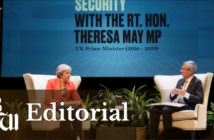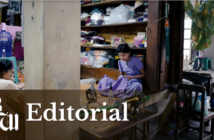It’s nearing 2 a.m., and the thump, thump, thumping of the nearby speakers has just claimed responsibility for the throbbing sensation somewhere in the vicinity of your left temple. Exhausted, you swill and down the dregs of your last cup and scan the faces of the surrounding crowd until you finally spot a few friends. You round the group up with a couple of pointed glances, and the half dozen or so of you wave a few quick goodbyes as you weave your way toward the party’s exit.
As your little group spills over onto the sidewalk outside, you see a man and a woman arguing with one another across the street. Loudly. Angrily. Aggressively. At first, you pass awkwardly by. But then they start shoving and grabbing one another with malevolent force. You and your friends immediately wheel around, tear the two apart and simultaneously dial 911.
But do you, really?
If you behave as most others do in groups, probably not. Instead, you’re more apt to succumb to what is known as “the bystander effect,” which occurs when the presence of others hinders an individual from intervening in an emergency situation, according to Psychology Today.
Social psychologists Bibb Latané and John Darley popularized the concept after the infamous 1964 murder of 28-year-old Kitty Genovese in Kew Gardens, New York, Psychology Today said. Genovese, a bar manager, had been on her way home from work when her assailant, Winston Moseley, attacked her with a hunting knife.
She screamed, and a nearby apartment tenant opened his window and shouted, “Leave that girl alone!” according to Nicholas Lemann of The New Yorker. Moseley ran away, and the wounded Genovese staggered to the back of her apartment building, seeking refuge inside a vestibule. But Moseley returned and stabbed her again, sexually assaulted her and fled before she died.
Arguably more disturbing than the murder itself, however, was the fact that “no fewer than 38 of (Genovese’s) neighbors came to their windows at 3 a.m. in response to her screams of terror — and remained at their windows in fascination for the 30 minutes it took (Moseley) to complete his grisly deed,” The New York Times reported.
As Latané and Darley stated, the bystander effect is the result of both the diffusion of responsibility and social influence inherent in group environments. As a consequence of the former, onlookers are more likely to intervene if there are few or no other witnesses, according to Psychology Today — and in terms of social influence, individuals in a group monitor the behavior of those around them to determine how to act.
Each onlooker then becomes likely to conclude from their neighbors’ inaction that their own help is unnecessary, according to Psychology Today.
In a less academic sense, we also can’t always be sure of what’s actually happening with others or whether a situation even calls for external intervention. People squabble all the time, so how can we possibly determine when someone may actually get hurt? In many cases, we simply don’t even think it’s our business, particularly because of the highly private and contentious nature of interpersonal conflict.
As always when in groups, we’re subject to conform to peer culture, behavior (or lack thereof) and general mentality. It’s hard to break away from a defined standard when that standard ensures us acceptance and a degree of social safety. And being in a group isn’t always what deters us from bystander intervention— in some instances, we may not want to risk our own individual safety, which is automatically threatened when we confront things alone.
But regardless of our reasons for avoiding intervention, our lack of action is unlikely to yield positive results — however unsure we are that those results will be negative.
In essence, as Brené Brown stated in a 2010 TED Talk, “We pretend that what we do doesn’t have an effect on people. We do that in our personal lives. We do that (on a) corporate (level) –whether it’s a bailout, an oil spill, a recall — we pretend like what we’re doing doesn’t have a huge impact on other people.”
But our actions do indeed have an impact, especially when it comes to potential crises. Unfortunately, those are rarely ever marked by blinking lights and neon arrows.
But when it concerns the welfare of our peers, it’s always better to be safe than sorry.





Comment policy
Comments posted to The Brown and White website are reviewed by a moderator before being approved. Incendiary speech or harassing language, including comments targeted at individuals, may be deemed unacceptable and not published. Spam and other soliciting will also be declined.
The Brown and White also reserves the right to not publish entirely anonymous comments.